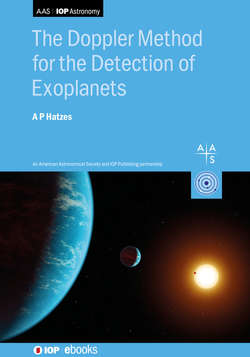Читать книгу The Doppler Method for the Detection of Exoplanets - Professor Artie Hatzes - Страница 25
На сайте Литреса книга снята с продажи.
2.3 Charge-coupled Device Detectors
ОглавлениеAfter a spectrograph has dispersed the light into its component wavelengths, you now need a detector to record the photons. CCD detectors are universally used on spectrographs working at optical wavelengths (≈3000–10,000 Å). There are three important advantages to using CCD detectors: (1) they have high quantum efficiency; (2) they are two-dimensional devices, ideal for recording the two-dimensional format of an echelle spectrum;3 and (3) the output is in digital form, making it easier to process the data. Here we will cover just the basics of CCD detectors.
The use of photographic plates at the turn of the last century certainly revolutionized both imaging and spectroscopic astronomical observations. Spectroscopists could not only record their observations, which is certainly easier than using your eye to detect Doppler shifts (like Huggins!), but photographic plates also enabled astronomers to integrate for long exposures, thus allowing the observations of fainter objects. In spite of this important development, photographic plates could rarely achieve S/N ∼ 20 for high-resolution spectra. If we define the quantum efficiency as the ratio of incoming to detected photons, photographic plates had a rather low quantum efficiency (QE) of 1%–3%.
The advent of electronic detectors played the first key role in improving stellar RV measurements. The first major developments, starting in the 1940s, came with photomultipliers, which provided a QE of about 10%, or a factor of 10 increase over photographic plates. By the early 1980s, photodiodes improved the QE to ∼50%. Currently, virtually all astronomical instruments employ CCDs. These devices saw routine use in the 1990s, and a modern CCD detector can have a QE of ∼80%–100%.
Figure 2.11 summarizes the evolution in quantum efficiency of detectors over the past decades and is the companion for detectors to Figure 1.4. Although the trend seems linear in a logarithm plot, the development came in quantum leaps (pun intended). For example, with photographic plates there was no improvement in the QE for many decades before photomultiplier tubes were developed. Since then, the developments have come much more rapidly, but still in steps.
Figure 2.11. The increase in the QE of astronomical detectors as a function of time.
It is interesting to reflect on how much CCDs have revolutionized observational astronomy. In the 1920s Edwin Hubble discovered the expansion of the universe using the Mt. Wilson 2.5 m telescope taking spectra of galaxies with photographic planets, often with exposure times of several days duration (and without autoguiding!). With CCDs, he could have achieved the same result with a 40 cm telescope!
